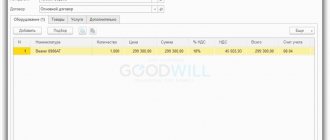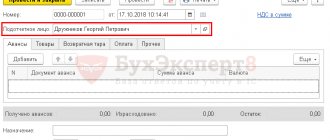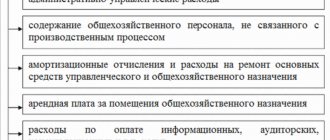Fixed assets that cannot be used for their intended purpose immediately after their delivery to the buyer’s site are subject to separate accounting. This group of assets requires pre-operational adjustment, modification, installation or equipping with additional technical elements. The category of such fixed assets may include both single pieces of equipment and large-scale technical complexes.
What primary documents should be used to document operations to record equipment for installation ?
Cost accounting for main production: general principles
The costs of main production for enterprises of any form of ownership and any type of activity are expenses associated with the main activity.
The first goal of business enterprises is to make a profit. This goal is achieved through the performance of specific functions (production, provision of services). These are the costs for performing these main functions and are reflected in account 20 “Main production”. Let us recall that in trading enterprises, costs associated with core activities can be reflected in account 44 - “Distribution costs”.
What are these expenses? In the debit of the 20th account, material costs, expenses for wages and social insurance of personnel of the main production are allocated to the expenses of the main production. It also reflects the depreciation of production equipment and other objects used for the same purposes (real estate, engineering structures related to production workshops). Here the cost of fixed assets less than 40,000 rubles is included in expenses. (clause 5 of PBU 6/01).
For more information on how to calculate depreciation, see the article: “Calculation of depreciation of fixed assets in 2016.”
The listed expenses form the direct production costs of the enterprise. Indirect costs are formed on the 25th and 26th accounts.
Note that the expenses of auxiliary production related to production costs are distributed proportionally to the expenses of the main production. Part of the costs on the credit of account 23, written off to the debit of account 20, also forms expenses for the main production of the enterprise.
The concept of equipment for installation in accounting
In accounting, the term “equipment for installation” combines a complex of depreciable tangible assets that must undergo a number of preparatory activities before the date of commissioning. These objects are characterized by the following properties:
- long-term use of the equipment is expected;
- high acquisition cost;
- after the start of operation, the asset is able to influence the amount of material benefit received by the enterprise;
- cannot be launched without initial installation on a special platform or work site; some types of equipment require the supply of communications, the creation of supports or preparation of the foundation;
- assembly of the main elements is required;
- Equipment may require setup and programming.
the commissioning of equipment in accounting ?
The group of fixed assets to be installed includes production, technological assets, energy and laboratory equipment.
IMPORTANT! Vehicles, agricultural and construction machines, tools used by production workers, household equipment and free-standing machines cannot be included in the equipment for installation.
Accounting for production costs when releasing products
The expenses of an enterprise engaged in the production of products are, as a rule, standardized. The company sets its own standards based on the technology used and economic and statistical calculations. If an enterprise does not have the opportunity to develop technologically sound standards, then standardization is carried out based on actual costs. In this case, the standard is usually taken as the average cost per unit of production. In order for the application of standards to be effective, established standards must be periodically analyzed, corrected, and supplemented.
To determine the planned and actual production costs, product cost calculations or cost calculations are compiled. In such calculations, the value of all types of direct and indirect costs per unit of production is established. Indirect costs are distributed in one of the following ways:
- by distributing indirect costs in proportion to material costs;
- by distributing indirect costs in proportion to the wages of key production personnel;
- distribution of indirect costs in proportion to production costs.
IMPORTANT! Expenses collected on account 26 may not be distributed to main production. In this case, accounting in the main production will be carried out at a reduced cost (direct production costs only). Then the amounts accumulated in the indirect costs account must be attributed directly to the cost of sales by posting Dt 90.2 Kt 26. Which method of accounting for production costs is chosen is necessarily recorded in the accounting policy of the enterprise.
Production costs include:
- materials for production;
- labor costs;
- costs for compulsory social insurance of production personnel;
- depreciation of production assets;
- other costs;
- costs of auxiliary production.
The cost items indicated above (except for the costs of auxiliary production), in accordance with clause 8 of PBU 10/99, form a grouping of expenses from ordinary activities by type of cost. The last point of the above classification may or may not be included in production costs by an enterprise. The adopted accounting method must be reflected in the accounting policy.
How to classify production cost items can be found here: “Classification of production cost items.”
Examples of closing an account in 20 other ways
The organization's accounting policies may indicate other methods of closing an account 20.
Subscribe to our newsletter
Yandex.Zen VKontakte Telegram
How is account 20 closed at the end of the month using the remaining methods: intermediate and direct implementation?
The conditions of the example remain the same as in the previous section - for ease of comparison of accounting using different methods.
IMPORTANT! The same wiring as the direct method is not repeated. Only differences are shown.
Intermediate method. Account 40 “Product Output” is used:
| 43 | 40 | 77 000 | Production of scooters at planned cost |
| The end of the month | |||
| 40 | 20 | 82 000 | Adjustment of production output |
| 43 | 40 | 5 000 | Adjustment of planned cost to actual cost |
| 90.02 | 43 | 3 636 | Adjustment of cost of sales |
Direct sales of products
| 90.02 | 20 | 56 000 | The planned cost of scooters sold was written off |
| The end of the month | |||
| 90.02 | 20 | 3 636 | Adjustment of cost of sales |
Accounting for expenses of service industries and farms
Service industries and farms are those structural divisions of an enterprise that perform functions not directly related to the main activities of the enterprise. Such service industries and farms may include:
- objects of the social structure that are on the balance sheet of the enterprise (dormitories, kindergartens, clubs, clinics, hospitals, dispensaries, sanatoriums, etc.);
- farms for the production of products not related to the main activity of the enterprise (for example, a pig farm at a metallurgical enterprise - its products are used to provide meat for workshop canteens and social facilities of the enterprise).
The debit of account 29 is used to reflect direct expenses associated with the activities of service industries and farms. The credit of account 29 reflects the actual cost of products and services produced by service industries and farms.
IMPORTANT! Account 29 does not correspond with account 20, as follows from the Chart of Accounts and instructions to it, approved by Order of the Ministry of Finance dated October 31, 2000 No. 94n. This is explained by the fact that, according to the meaning of the transactions for which account 29 is provided, it should not reflect anything that could form the production cost of the types of main products produced.
Postings to account 20 in accounting
The Chart of Accounts and Instructions for its application (Order No. 94n) suggest the following entries for account 20:
- Accrual of production costs:
| Debit | Credit | Contents of operation |
| 20 | 02, 05 | Depreciation on production fixed assets and intangible assets is reflected |
| 20 | 10, 16 | Materials, equipment, workwear used in production are taken into account |
| 20 | 19 | Non-refundable VAT on materials, works, services is included in the cost price |
| 20 | 21, 23 | Semi-finished products and auxiliary production products are written off |
| 20 | 25, 26 | General production and administrative expenses are taken into account |
| 20 | 28 | Defects included in production costs |
| 20 | 60, 76 | The work and services of third-party organizations for production needs have been accepted for registration |
| 20 | 69 | Social contributions accrued from workers' salaries are reflected |
| 20 | 70 | Calculated wages for workers |
| 20 | 71 | Travel expenses included |
| 20 | 91.1 | Excess work in progress has been capitalized |
| 20 | 94 | Shortages and losses within the limits of norms, without perpetrators |
| 20 | 97 | Accrued deferred expenses for main production |
- Postings for closing account 20 at the end of the month:
| 10, 15 | 20 | Returnable waste and own material assets (containers, for example) are capitalized |
| 21 | 20 | Finished semi-finished products are written off |
| 28 | 20 | Costs for eliminating defects are taken into account |
| 40, 43 | 20 | Manufactured products are capitalized (their cost is written off) - using the direct or intermediate method |
| 45 | 20 | Products, works, services transferred to third parties |
| 90.02 | 20 | The cost of products sold, work performed, services written off - for direct sales |
| 94 | 20 | Reflected shortage in main production |
Accounting for expenses of auxiliary production
Account 23 “Auxiliary production” accumulates information about expenses in the divisions of the enterprise that are classified as auxiliary. These divisions include:
- transport workshops (at enterprises that are not transport companies);
- repair shops;
- tool workshops, workshops for the production of tools and equipment, processing shops;
- units for the construction of non-title (temporary) structures;
- divisions for the extraction of non-metallic materials (stone, gravel, sand);
- logging and sawmill divisions;
- workshops for processing agricultural products (as part of agricultural enterprises whose main activity is growing, rather than processing agricultural products).
The debit of account 23 reflects the formation of direct costs. The indirect costs of managing and maintaining auxiliary workshops are also written off to the debit of account 23 from the credit of accounts 25 and 26. If the technological cycle and accounting system at the enterprise allows, then the costs of servicing and managing auxiliary production can also be collected directly on account 23.
Posting Dt 20 Kt 23 reflects the release of work, services, products produced by auxiliary shops to the main production of the enterprise. If products and services of auxiliary production are sold to service farms, then posting DT 29 Kt 23 is used.
Auxiliary workshops can provide services and produce products intended for third parties. In this case, to write off the cost generated according to Dt 23, the following posting is relevant: Dt 90 Kt 23.
The analysis of expenses is carried out in the context of various auxiliary productions, therefore, for analytical accounting, subaccounts of the 23rd account are opened for the types of auxiliary workshops. The balance of account 23 shows the cost of work in progress in auxiliary departments.
Meaning of 23 accounts
Position 23 in the Chart of Accounts, known as “Auxiliary Production”, is intended to summarize information about the costs of departments that are considered non-core.
If we consider in more detail, it should be said that this account is used to reflect the expenses of those departments that provide:
- transport service;
- OS repair work;
- production of spare parts, tools, building structures;
- construction of temporary structures;
- canning, salting or drying agricultural products.
The debit part of the account should reflect direct costs that are directly related to the production of products, as well as indirect costs that occur due to the need to manage and maintain the work of auxiliary structures, as well as losses due to defects.
In the credit part of the invoice it is necessary to show the actual cost of the finished product. All these amounts should be written off to the debit side of such accounts as main production (20), sales (90), and release of goods (40).
Manufacturing Cost Accounting: Example
Let's look at an example.
1. Technological standards establish that the production of one set of linen requires:
- 8.5 m of calico at a price of 110 rubles/linear. m;
- 2 spools of sewing thread, 200 m each, priced at RUB 14/spool;
- 12 m of cotton stitching at a price of 50 rubles/m.
All prices are excluding VAT.
2. The production rate of workshop No. 1 for sets of bed linen per month is 1,000 pieces.
In the first sewing workshop, where the production of these sets is planned, 4 seamstresses work. The production norm for one seamstress is 250 sets.
3. The salary of one seamstress per month is set at 15,000 rubles.
4. Payroll charges: PFR - 22%, FSS for temporary disability and maternity - 2.9%, FFOMS - 5.1%, FSS for injuries - 0.4%. Total payroll accruals - 30.4%
ATTENTION! On July 11, OKVED-2 (OK 029-2014, NACE rev. 2) came into force, but occupational risk classes are still tied to OKVED-1. In accordance with OKVED-2, the production of such garments as bed linen belongs to class 13. According to OKVED-1, this type of activity is related to class 18 - production of garments - and has a 3rd class of professional risk with a rate of 0 ,4%. Starting from 2021, this discrepancy will be eliminated by legislators, but do not forget to submit to the Social Insurance Fund information about the main type of activity for 2021 by April 1, indicating the new OKVED-2 code (according to OK 029-2014).
5. The payroll for the second sewing workshop is 250,000 rubles. per month.
6. Auxiliary production - sewing machine adjuster. Works for two sewing shops. The adjuster's salary is 25,000 rubles/month.
7. The salary of the master of the first sewing workshop is 17,000 rubles/month.
8. Shop No. 1’s electricity costs are 1,200 rubles/month. (without VAT). An electricity consumption meter is installed in the workshop.
9. Heating costs for the entire building of production workshops - 35,000 rubles/month. Excluding VAT.
10. Depreciation of equipment installed in workshop No. 1 - 4,500 rubles/month.
11. Other production costs of the 1st workshop - 12,500 rubles/month.
12. Administrative expenses - 685,000 rubles/month.
13. Sales expenses - 140,000 rubles. /month
14. According to the accounting policy, finished products are accounted for at full cost. General production and general business expenses are distributed in proportion to the wages of production workers.
The kits were produced in December 2021. All products were sold in December.
Let's calculate:
- Production cost of 1 set.
- Production costs of the 1st sewing workshop for December.
- The full cost of 1 set of linen.
Table 1. Production cost per unit of production.
| No. | Costing items | Calculation | Quantity per unit | Price per one. change | Amount, rub./set |
| 1 | Plain dyed cotton calico | 8,5 × 110 = 935 | 8,5 | 110 | 935,00 |
| 2 | Cotton sewing threads | 2 × 14 = 28 | 2 | 14 | 28,00 |
| 3 | Cotton machine stitching | 12 × 50 = 600 | 12 | 50 | 600,00 |
| 4 | Seamstress salary | 15,000 / 250 sets = 60 rub./set. | 60,00 | ||
| 5 | Foreman's salary | 17,000 / 1,000 sets. = 17 RUR/set. | 17,00 | ||
| 6 | Social security contributions | (60 + 17) × 0,304 = 23,41 | 23,41 | ||
| 7 | Electricity | 1200 / 1 000 = 1,20 | 1,20 | ||
| 8 | Depreciation | 4 500 / 1 000 = 4,50 | 4,50 | ||
| 9 | other expenses | 12 500 / 1 000 = 12,50 | 12,5 | ||
| Total production cost per unit of production | 1 681,61 |
Thus, the production cost of one set of bed linen was 1,681.61 rubles.
Table 2. Production costs of workshop No. 1 for December.
| No. | Grouping costs by element | Quantity per volume | Price per one. change | Amount, rub./set |
| 1 | Material costs | |||
| 1.1 | Plain dyed cotton calico | 8,5 × 1 000 = 8 500 | 110 | 935 000,00 |
| 1.2 | Cotton sewing threads | 2 × 1 000 = 2 000 | 14 | 28 000,00 |
| 1.3 | Cotton machine stitching white | 12 × 1 000 = 12 000 | 50 | 600 000,00 |
| 2 | Payroll of the workshop | 15 000 × 4 + 17 000 = 77 000 | 77 000,00 | |
| 3 | Payroll accruals | 77 000 × 0,304 = 23 408 | 23 408,00 | |
| 4 | Electricity | 1 200,00 | ||
| 5 | Depreciation | 4 500,00 | ||
| 6 | other expenses | 12 500,00 | ||
| Total production cost of volume | 1 681 608,00 |
Table 3. Total unit cost of production of sewing shop No. 1 for December
| No. | Grouping costs by element | Calculation per unit | Amount, rub./set |
| 1 | Material costs | pp. 1–3 tables 1: 935 + 28 + 600 = | 1 563,00 |
| 2 | Labor costs for key production personnel | item 4 table. 1 | 77,00 |
| 3 | Payroll accruals | item 5 table. 1 | 23,41 |
| 4 | Electricity | item 6 table. 1 | 1,20 |
| 5 | Depreciation | item 7 table. 1 | 4,50 |
| 6 | Other expenses of workshop No. 1 | item 8 of table 1 | 12,50 |
| Total production cost | 1 681,61 | ||
| 7 | Workshop heating costs | 35 000 × 77 000 / (77 000 + 250 000) / 1000 = 35 000 × 0,24 / 1 000 = | 8,24 |
| 8 | Support staff salaries | 25 000 × 77 000 / (77 000+250 000) / 1 000 = 25 000 × 0,24 / 1 000 = | 5,89 |
| 9 | Payroll accruals for support staff | 25 000 × 0,304 × 0,24 / 1 000 = | 1,82 |
| Total costs including overhead costs per unit of production | 1 697,56 | ||
| 10 | Administrative expenses | 685 000 × 0,24 / 1 000 = | 161,30 |
| 11 | Sales costs | 140 000 × 0,24 / 1 000 = | 32,97 |
| Total total cost per unit of production | 1 891,83 |
We will allocate expenses to main production and write off production expenses to the cost of products sold.
Table 4. Write-off of production costs
| Dt | CT | Amount, rub. | Operation description | Source documents |
| 20 | 10 | 1 563 000 (935 000 + 28 000 + 600 000) | Write-off of materials for production | Requirement-invoice, limit-fence cards |
| 20 | 70.1 | 77 000 | OPP salary | Payroll statement |
| 20 | 69 | 23 408 | Payroll accruals | Accountant's calculation |
| 20 | 60 | 1 200 | Electricity | Electricity delivery certificate for December from the energy supply company |
| 20 | 02 | 4 500 | Depreciation | Help-calculation |
| 20 | 76, 60 | 12 500 | other expenses | Agreements, acts, invoices |
| 20 | 26 | 8 240 | Heating | Help-calculation |
| 20 | 23 | 5 890 | Salary of the auxiliary workshop | Help-calculation |
| 20 | 23 | 1 820 | Payroll accruals | Help-calculation |
| 20 | 26 | 194 270,0 | Sales and administrative expenses are written off to the cost of finished products. | Help-calculation |
| 43 (40) | 20 | 1 891 828,00 | Finished products accepted for accounting | Help-calculation |
The cost of finished products released from the main production and sold in December amounted to RUB 1,891,828.00.
Example of closing account 20 directly
Task. The company produces scooters. During the month, 22 products were manufactured, 16 of which were sold at a price of 6,000 rubles. The planned cost is 3,500 rubles. a piece.
The amount of production costs is 82,000 rubles. (materials - 62,000 rubles, depreciation - 3,074 rubles, wage fund - 16,926 rubles (salary - 13,000 rubles, insurance premiums - 3,926 rubles)).
Direct method. Accounting for product output - on account 43 “Finished products” (without using account 40):
| Debit | Credit | Amount, rub. | Contents of operation |
| 20 | 10 | 62 000 | Raw materials for scooter production written off |
| 43 | 20 | 77 000 | Production of scooters at a planned cost of (3,500 × 22) |
| 62 | 90.01 | 96 000 | Sales revenue (16 × 6,000) |
| 90.03 | 68 | 14 644 | VAT charged (96,000 / 118 × 18) |
| 90.02 | 43 | 56 000 | The planned cost of scooters sold was taken into account (3,500 × 16) |
| The end of the month | |||
| 20 | 70 | 13 000 | Workers' wages accrued |
| 20 | 69 | 3 926 | Insurance premiums accrued (13,000 × 30.2%) |
| 20 | 02 | 3 074 | Depreciation of machines taken into account |
| 43 | 20 | 5 000 | Adjustment of production cost (82,000 – 77,000) |
| 90.02 | 43 | 3 636 | Adjustment of cost of sales (82,000 / 22 × 16 – 56,000) |
Results
The production cost of products is formed on the 20th account. General production and general business expenses:
- are allocated to production costs in proportion to one of three indicators: material costs, wages and direct production costs of products, if the accounting policy provides for accounting at full production costs;
- are charged to the cost of sales (debit of account 90), if the accounting policy establishes accounting at a reduced cost.
Service industries and farms, the costs of which are formed on the 29th account, have no relation to the main production. Auxiliary shops of the main production can both sell products (provide services) to other divisions within the enterprise, and sell part of the products (work, services) to the outside.
The production cost of finished products is formed on the 40th or 43rd account.
You can find more complete information on the topic in ConsultantPlus. Free trial access to the system for 2 days.
Corresponding accounts
As for correspondence with other accounts, in the debit part these could be:
- depreciation charges (02);
- NMA (04);
- depreciation calculation for intangible assets (05);
- materials (10);
- settlements with suppliers and contractors (60);
- other expenses and income (91).
Speaking about the combination with accounts on the credit side, here it is worth highlighting:
- installation equipment (07);
- contribution to non-current assets (08);
- key production (20);
- manufacturing defects (28);
- finished products (43).





